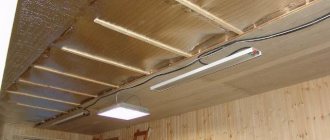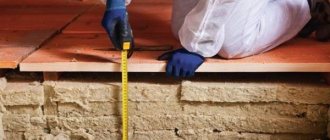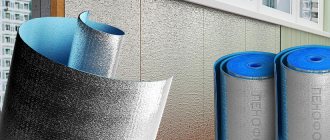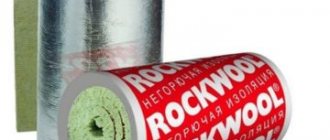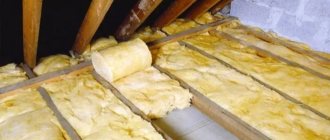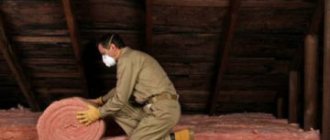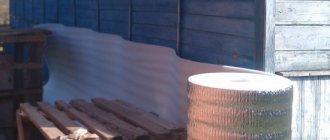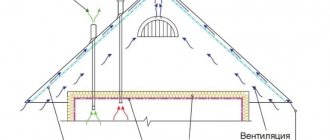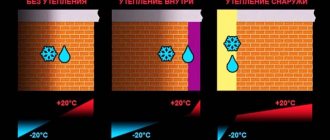Different materials are used to insulate the ceiling surface. In some cases, not only the thermal conductivity of the thermal insulation layer is important, but also its thickness. This is especially important when installing insulation on the residential side. Insulating the ceiling with foil insulation provides many advantages, but the main one is maintaining the height of the room. Let's consider the features, advantages and disadvantages of foil heat insulators, as well as the nuances of their installation on the ceiling surface.
Technology for installing penofol to the ceiling with glue
The use of an adhesive solution reduces the installation work of penofol to the ceiling from inside the room. This method does not require specific fasteners and is easy to use. Due to the fact that the material is light in weight, there is no need to calculate the volume of glue. If you plan to use penofol as the only insulation, it is recommended to choose a product with sufficient thickness.
- Cleaning the ceiling surface from old plaster and coating. A flat surface should be achieved and, if necessary, treated with sandpaper and plaster.
- Pathogenic microorganisms should be scraped off with a spatula. Then the treated area is doused with a hot stream of air and treated with antiseptic solutions.
- If there are stains of grease and oil, wipe with a solvent.
- Cracks, chips and gaps in the ceiling are sealed with a mortar of cement and sand.
- If the ceiling is made of wood and there are gaps, then they are filled with caulking; large cracks are eliminated with tow and PVC film.
- Wooden elements are coated with protective anti-flammable and anti-rotting agents. Each new layer is applied after the previous one has dried 100%.
- All sharp protruding elements that could damage the integrity of the foil are eliminated.
- Next, the ceiling is treated with a primer that is suitable in composition for the adhesive for fixing penofol. This stage is mandatory, because allows you to improve the quality of adhesion to the surface.
- Preparation of glue. If you choose a material with a sticky base, then it is enough to remove the protective film and then carefully attach the penofol to the ceiling.
- If a regular material is chosen, then a thin layer of adhesive solution is applied to its surface. At the same time, the work is carried out evenly, without gaps. Carefully coat the edges and leave for 1 minute.
- Then, the foam sheet is pressed against the ceiling or the first layer of insulation. Gently smooth out until it sticks. The joints are fixed with reinforced tape or sealant with a silicone base. Joints must not be left untreated.
During installation, you must ensure that the canvas ends in the corner of the room. It is prohibited to install the material overlapping. Additionally, you should monitor the contact points between the wiring and the foil. This is due to the fact that foil is an excellent conductor of current. In view of this, you should make sure that the wires close to the insulation are insulated.
Finally, decorative work is carried out. For example, this could be the installation of a suspended ceiling structure.
https://youtube.com/watch?v=7JzfukVKikQ
Nuances
All joints between individual sheets of insulation must be carefully taped with construction tape. If you don’t have it on hand, you can go over all the seams with silicone sealant. In any case, joints should not be left untreated.
It is advisable to avoid joints at corner connections between the ceiling surface and the walls. Do not allow the foil side of the heat insulator to come into contact with power supply wires and cables. Aluminum conducts electricity well, therefore, all places where the heat insulator comes into contact with wires must be carefully insulated.
Penofol cannot be glued overlapping. Condensation may flow along its edge, which will appear if moist air gets on the inner surface of the material.
How to calculate the thickness of penoplex for high-quality insulation
In order to accurately determine the required thickness of extruded polystyrene foam, you should take into account the material of the wall that needs to be insulated, its thickness, and the features of the finishing.
Thermal resistance is calculated. The data is determined based on SNiP readings for a specific region. So, for the central region this figure is close to 3.
The thermal resistance of each layer of the cake is different, so it is determined by adding the indicators of each layer and their thickness.
According to the formula, the thermal conductivity coefficient is determined as follows:
P=R/K, where R is the layer thickness, K is thermal conductivity.
Each material has its own thermal conductivity.
Calculation of penoplex thickness
After determining the values of the coefficients of all layers from the regional indicator (in our case it is equal to 3), the sum of all coefficients should be subtracted. This results in the thickness of the insulation layer.
IMPORTANT! As a rule, penoplex up to 30 mm thick is used for internal thermal insulation. The manufacturer recommends using “Wall” penoplex for interior finishing
The manufacturer recommends using “Wall” penoplex for interior finishing.
How to insulate a ceiling?
Laying penofol on the ceiling
Experts recommend penofol as an ideal thermal insulator for the ceiling. This opinion is due to its low weight and small thickness, as well as the minimal amount of effort that will be required to be applied by the person carrying out the installation.
To successfully carry out the work, the contractor, in addition to penofol, will need wooden slats, hardware, tools and facing material.
Execution sequence:
- Thermal insulation of the ceiling is carried out in two steps. First, using wooden slats, the initial layer is attached to the surface. For this, the thinnest type of penofol is usually chosen. When fixing the first layer, the slats are laid in the longitudinal direction, and when attaching the next layer, in the transverse direction.
- Insulating materials are covered with cladding made of foam plastic or other lightweight materials.
Material structure
Foil penofol has several layers in its structure. It is classified as reflective insulation. The main functions of penofol include the protection of various structures from the effects of wind and condensation. This material perfectly protects the room from extraneous sounds. Penofol is a universal material. Its many positive properties are explained by the subtleties of production and the structure of the products.
You might be interested in:
- Using decorative crushed stone for landscape design: photo
- Design project for a garden for a private house in a village: tips, photos
- The use of ornamental grasses and grasses in landscape design
- Materials for interior decoration of a country house made of aerated concrete
- How to straighten corners in a bathroom
- Foam insulation technology
- Bathroom wall panels
- Asymmetrical cast iron bathtub
The popular insulation is based on polyethylene foam. The pores in it are filled with air and completely closed. Foam is produced in rolls of different thicknesses. Various modifications of the material differ in density and structure. Polyethylene foam is covered with aluminum foil. It can be located on one or both sides. The foil is first subjected to special treatment. It is polished by heat welding. This increases the adhesion of the material.
The base can be made up to 10 mm thick. The foil is only 12-30 microns thick. The total thickness of the roll material is 40 mm. This insulator is used more often in areas with harsh climates. The principle of operation of penofol is quite simple. It is based on the work of the “Dewar vessel”.
Back in the 20th century, James Dewar realized that each substance differs in a certain degree of heat conduction. Regardless of this characteristic, the material used for insulation can only slow down the process of heat transfer to the room. However, it cannot be stopped completely.
In this case, the substance accumulates thermal waves and, accordingly, energy. After a certain period of time, the material becomes oversaturated, causing it to release heat.
James Dewar conducted many experiments to understand which materials tend to reflect thermal radiation. Among such materials are precious metals – silver and gold. Aluminum, which does not have impurities, perfectly reflects heat. When reaching the metal surface, thermal radiation is reflected. The percentage of reflection reaches 99. However, reflectors are excellent heat conductors. Therefore, to insulate rooms they must be used in conjunction with good insulation materials.
A simple thermos works on a similar principle. The famous scientist’s research became the basis for the creation of space suits. In addition, heat insulators with reflective properties are created using the same scheme.
Important! The use of insulation with one or two reflective sides significantly reduces the cost of heating a home in winter. In summer, rooms heat up more slowly
Penofol and isolon - their properties and characteristics
Foamed polyethylene serves as the base in these materials. The reflective foil coating can be on one or both sides.
The following types of these thermal insulation materials can be found on sale:
- Variety “A” has a one-sided foil coating.
- Category B materials have reflective foil on both sides.
- Insulators marked “C” have a reflective layer on one side and a self-adhesive base on the other.
- Materials of the “ALP” category are insulators with a double-sided reflective layer, one of which has a protective coating in the form of a film.
- Another type of heat insulator with one-sided foil coating is insulation marked “M” and “R”. Their difference from category “A” is that the material has a relief structure.
On a note! There is a special group of foil-coated heat insulators that are used in the installation of pipelines, heating mains and air ducts. They are marked with the designation “NET” and “AIR”.
To insulate the ceiling in residential premises, heat insulators of the first three categories are used. Moreover, the first type performs better as a vapor barrier, so it is used only in conjunction with other insulation materials. Only types “B” and “C” are allowed to be used as independent thermal insulation materials.
If the ceiling is insulated with penofol from the inside, then the strips of material are laid only end-to-end, and all seams are taped with reinforced tape. In order for the effectiveness of such thermal insulation to be higher, an air gap must be left on both sides. To do this, a lathing is constructed on the base ceiling, after which an insulator is attached, and another lathing is made from slats, to which the finishing coating is subsequently sewn.
Attention! For effective insulation, the material is mounted with a reflective layer inside the room.
It is prohibited to install foil insulation overlapping. Because of this, the effectiveness of insulation is reduced. Moreover, in areas of overlap between two surfaces, condensation accumulates, which then flows into the room.
Foamed polyethylenes with a reflective coating are practically not used as independent heat insulators. As a rule, they are used in combination with mineral wool, polystyrene foam and extruded polystyrene foam. The only case when such material can be used as the only insulation is when it is mounted on a ceiling above which there is a room where the temperature does not drop below 10-15°C.
Differences between the two materials
Izolon is a polymer insulation with a closed-cell polyethylene structure. It is suitable for insulating rooms and protecting them from external noise.
Characteristics of mineral wool and technology for insulating the ceiling in a private wooden house
The following types of isolon are on sale:
- based on self-adhesive tape;
- insulation made of uncrosslinked polyethylene (grade 100);
- insulators made of chemically cross-linked polyethylene (grade 300);
- Isolon made from physically cross-linked polyolefin foam is a material marked 500;
- heat insulator with a reflective layer of metallized lavsan film.
Izolon has low thermal conductivity and protects surfaces well from moisture and steam. Its density is 20-100 kg per cubic meter. The foil layer reflects 97% of infrared radiation.
To produce penofol, several layers of polyethylene foam are used, each of which has a different density, thickness and porosity. A reflective layer of foil is attached to it on one or both sides. Penofol is very light and thin. It is suitable for insulating a room, and also performs the functions of vapor and waterproofing. The material is inexpensive and easy to install, so it is very popular.
Important! The only difference between isolon and penofol is the structure of the material. Thus, penofol is made from layers of polyethylene foam, and izolon is made from chemically or physically cross-linked polyethylene foam.
Pros and cons of foil insulation
The advantages of insulators with a reflective layer are as follows:
- The material is very light, so it is suitable for installation even on dilapidated foundations without preliminary strengthening.
- If we compare penofol and isolon with rigid slab insulation, then due to its flexibility and elasticity, polyethylene foam is suitable for installation on any shaped base without leveling.
- Insulation with a small thickness after installation on the ceiling does not reduce the height of the room.
- Since foil insulators simultaneously perform the functions of insulation, vapor and water barriers, during their installation you can significantly save on the purchase of materials and fastening devices. This reduces the cost and speeds up installation work.
- The material is easy to process. It is simply cut with scissors or a cutter.
- Foamed polyethylenes have zero water absorption, so they do not absorb moisture and protect the base from it. This ensures a longer service life of the floor structures.
- The material is harmless and safe for humans, so it can be used in residential areas.
- The insulation is not damaged by rot, mold, rodents and insects.
- The material is simply and quickly mounted on the base.
- Low price is the main advantage and reason for the popularity of insulation.
Insulators made of polyethylene foam are flammable, this is their main disadvantage. During a fire, the material quickly melts and begins to drip, facilitating the spread of fire. These insulators are not suitable for use as independent insulation. Their effectiveness has been proven only when used in conjunction with more reliable thermal insulation materials (mineral wool, expanded polystyrene and others).
What is roofing foil? And what is it for?
This material is a type of roof film that is laid on it for one purpose - to improve thermal insulation. Roofing films are relatively expensive materials, so a mistake in choosing the material can be costly.
The application of foil roofing film can improve the durability of the roof, as well as the building as a whole. This material indirectly affects the thermal parameters of individual rooms, especially if your house has an attic or attic. Thanks to the presence of foil in the roof, you can achieve the correct energy balance of the house, which allows you to reduce heating costs.
In addition, correctly selected foil guarantees the tightness of the roof. Therefore, heating costs are reduced, and the house itself becomes warmer. By laying the roofing film on the roof, we can be sure that the thermal insulation layer will remain dry, which means that fungi and mold will not appear on it, which affects the durability of the entire roof structure.
Varieties
Despite its apparent simplicity, it has several varieties that differ greatly in their characteristics:
- Type "A". This is the most common species. It is covered with a foil layer on only one side.
- Type "B". The foil coating is already on both sides of the material.
- Variety marked “C”. It will differ from the others by the presence of a self-adhesive coating on one side. This is a very useful feature during installation.
- The type of polyethylene foam, marked with the letters “ALP”, has a foil layer on both sides, but at the same time, one of the foil-covered sides is also protected by a film coating.
- Penofol types “R” and “M” have foil on only one side, but have a relief structure.
- Products marked “AIR” are used to create air ducts.
- Another type, marked with the word “NET”, is used for thermal insulation of heating mains, air ducts and pipelines.
The last four types are not used very often, but rather on a specialized basis. Therefore, you are unlikely to encounter them in everyday use. But polyethylene foam, designated by the letters “A”, “B” and “C”, can be found much more often, and is actively used for domestic purposes, among which the main thing will be the insulation of all kinds of surfaces.
The first type of this heat insulator is mainly used as an auxiliary material when creating a thermal cushion. It works well as a vapor barrier.
For complete heat conservation, a material with more significant characteristics is needed. It is best to create an independent layer of thermal insulation, use either polyethylene foam, marked with the letter “B”, or, a variety, marked “C”.
What is it for?
High humidity and temperature in the steam room of a Russian bath require a special approach
It is important to protect the heat-insulating layer from moisture. Why protect him? The fact is that basalt wool is most often used for thermal insulation of premises.
In a dry state, it has good heat-insulating qualities, is made from natural materials, and tolerates high temperatures well. But in an important state, its thermal conductivity increases greatly, and it protects less well from heat loss. And if it freezes when wet, it will completely crumble. That is why it is necessary to protect it from moisture in any condition. Both from liquid (waterproofing) and from steam:
- From moisture coming from the room. The humidity in the Russian steam room is very high, the air is oversaturated with moisture, so the steam tends to flow into other rooms and outside (through the heat insulator). And we need to avoid this.
- From moisture formed due to temperature changes in the steam room and in the attic and on the street (and on the interfloor ceiling and on the walls). It condenses even before steam begins to be supplied, during the heating of the air in the steam room.
Features of ceiling insulation in a wooden house
When working with wooden buildings, primary attention should be paid to the final weight of the insulating layer. Excessively high mass increases the likelihood of collapse or cracks in the ceiling covering
Some are trying to insulate the ceiling in a private house with a cold roof by reducing the insulation layer, but work standards require a certain value for each region in accordance with temperature and humidity indicators. As the thickness decreases, the thermal insulation properties decrease, and the meaning of laying insulation disappears.
Insulation of the ceiling in a wooden house from the inside
Advantages and disadvantages of the method
Insulation with foil has a number of features and a minimum of negative aspects. Advantages:
- Foil reflects heat. Thus, the heat remains in the house, on the other hand, it does not allow heat to enter the house in the summer.
- Increased wear resistance.
- Partially applicable as a waterproofing material.
- Easy installation, light weight, simple dismantling.
- The insulation does not allow cold wind to pass through. Maximum insulates from external influences. Resistant to deformation due to sudden temperature changes.
- Keeps out noise from the street.
- Does not rot or mold.
- This material is thinner than others, but is 20-30% more effective.
- The insulation does not emit substances harmful to health and prevents the smallest irritants and allergens from getting inside.
- There is no rigidity, so the top cannot be covered with plaster or wallpaper.
- Special adhesives are required for fixation.
- Sometimes insulation with foil is not enough to insulate a room.
Despite the disadvantages, foil material is widely used for various purposes.
What glue should I use Penofol?
When it is necessary to glue polyethylene foam, preference should be given to special compounds that ensure adhesion and do not damage the structure of the thermal insulation.
Water-based compositions will not be effective; at the same time, the operating conditions of the adhesive joint must be taken into account. Among the popular brands, it is worth noting Thermaflex TermaEco adhesive, Armaflex 520 and K-Flex K 467 contact adhesive. All of them are specially designed for gluing PPE.
How to paint polyethylene foam insulation, read the link.
Still have questions about choosing Penofol, application and fastening? Then quickly dial the number. Our managers will provide a completely free consultation and help with calculating quantities and placing an order.
Advantages and disadvantages
Before using insulation, you should also consider its advantages and disadvantages. The advantages include:
- good reflection of heat rays, which allows for a good indoor climate not only in winter, but also in summer;
- high wear resistance;
- insulation can partially serve as a waterproofing agent;
- small weight;
- ease of mounting and dismantling;
- does not deform under the influence of cold or hot air;
- protection from street noise;
- absence of harmful components in the composition of penofol;
- fire resistance;
- the layer has a thickness of 4 mm, while it is more effective than other materials;
- no need for additional vapor barrier;
- resistance to the influence of biological factors: mold or mildew does not form on the surface of penofol, it does not rot;
- ease of transportation and installation.
This insulation also has disadvantages. It is soft, so it is not suitable for finishing with plaster or wallpaper. To secure the material to the surface, you will have to purchase special adhesives. Penofol is not always enough for maximum insulation.
Criterias of choice
To choose penofol for wall insulation, you need to consider the following recommendations:
- for quick and convenient installation, you should not buy material whose thickness is less than 5 mm;
- if you need wall decoration in rooms with high humidity and frequent temperature changes, then it is better to choose foil-clad polypropylene;
- when choosing insulation, you need to pay attention to how well the foil part is polished (the quality of reflection of heat rays depends on this parameter);
- The roll contains 9-18 square meters of material. grounds;
- If the material is sewn, then it is better not to buy it.
As for manufacturers, it is better to give preference to those companies that have a positive reputation. They guarantee the necessary technical characteristics of penofol.
Ceiling insulation
Penofol allows you to insulate the ceiling in the best possible way, since the material is thin and light in weight. In addition, its installation will require minimal effort.
Ceiling insulation with foam insulation
Before insulation, you will need to ensure that you have:
- penofol;
- wooden slats;
- hardware;
- metalworking tools;
- cladding.
Execution technology
- Thermal insulation of the ceiling surface is provided in two steps. The initial layer is fixed to the ceiling by means of slats in the longitudinal direction. The next layer is similar in the transverse direction, with the material extending onto the walls within 100mm. The slats are secured with self-tapping screws.
- A cladding made of plastic, foam, or other lightweight component is installed on top of the installed layers.
Scope of application
Foil penofol is often used to insulate houses, baths, and saunas. In addition, the areas of application of the material are as follows:
- residential buildings, country houses, multi-storey structures;
- industrial and administrative buildings;
- kindergartens, medical institutions;
- hangars and warehouses;
- ventilation and heating systems;
- railway cars;
- large vehicles, refrigerators.
In residential buildings, attics, attics, interior spaces (walls, ceilings, floors), balconies and loggias, and heating pipes are insulated with penofol. It also strengthens the outer insulating layer.
Floor mounting
Laying an insulating coating on the floor has its own nuances. The first feature when installing on this base is the need for its leveling.
To do this, a concrete screed can be pre-formed. A cement solution in liquid form is used. They pour it onto the floor surface. There is no additional need to level the cement: this happens automatically. As a result, a flat base is formed on which the heat insulator can be laid. After the screed has completely dried, which can take from several days to several weeks, depending on the weather and humidity in the room, proceed to the next step. Experts do not recommend laying a PE heat insulator with aluminum protection directly on the screed. It is better to put foam plastic on the base: this will create an additional layer, due to which the insulation efficiency will significantly increase. Use sheets of polystyrene foam seven to fifteen centimeters in size. Next, proceed to the installation of the heat insulator. The procedure depends on what type of insulating coating is chosen. So, A requires the use of glue. It is applied to the foam, ensuring uniform distribution: this is important for strong fixation of the insulator. Then lay the insulating coating and press it down so that the adhesive sets. C does not require glue: this type of heat insulator initially has an adhesive base on the back side. And so that during the installation process it does not dry out prematurely, it is covered with a PE film. Immediately before installation, it is carefully removed, and then the insulator is laid out on the foam and fixed on it, lightly pressing with a special soft roller. When laying on the floor, it is important to place the insulating coating so that the sheets overlap the wall surfaces by approximately 5 centimeters - overlapping. It is important to glue the joints between the insulator fragments using special aluminum-based LAMS tape. This will prevent moisture from penetrating under the insulation. Lay the insulator so that the side where the aluminum is located is turned into the room
This will ensure effective steam, heat and noise insulation. When the installation process is complete, the excess insulation coating is carefully cut off using an installation blade.
Nuances of foam installation technology
Thermal insulation construction with penofol provides a preparatory stage and selection of the necessary tools. The condition of communications and the structure itself is first checked. If there are grooves or other defects on the base, they need to be repaired with putty. There should be no dust or dirt on the surface. It is thoroughly cleaned with sandpaper.
Tools and materials
To insulate a structure with the specified material, the following tools are required:
- building level, knife, tape measure;
- stapler and staples;
- spatulas;
- marker;
- electric drill;
- screwdriver;
- sandpaper.
Dowels are often used to secure the material. During preparation, a primer must also be applied to the base. If the base is wooden, then it requires additional antiseptic and fire retardant treatment.
Insulation of house walls from the inside
Insulation of walls from the inside is carried out in the following order:
- Making a frame from wooden slats. In this case, a space of 2 cm should remain on both sides of the penofol. Thus, the effect of the insulation will be maximum. The sheathing must be secured using dowels. The pitch between the slats is 1 m.
- Insulation of electrical wires. The aluminum foam layer has a high level of electrical conductivity.
- Fastening the material. A furniture stapler and staples are used for fixation. Strips of the required width or length are cut with a construction knife. To improve the thermal insulation properties, the seams between the elements are taped with masking tape. It is not recommended to lay strips overlapping.
After the insulation is secured, the wooden frame is reinstalled. Chipboard or MDF can be fixed on it for subsequent finishing.
External wall insulation
To insulate a house from the outside, it is better to use a perforated type of material. It not only provides good insulating properties, but also helps remove steam from the room. Exterior finishing is done if there is no desire to change anything inside the building. Work should be carried out in warm weather on a dry base. Installation involves the following steps:
- Treating walls with antiseptic.
- Making a wooden frame. Self-tapping screws are used for fastening.
- Laying the insulation while maintaining a two-sided gap of 2 cm. The joints are connected with metallized tape.
Now you can make another wooden frame and begin finishing the building.
Ceiling insulation
Installation of insulation on the ceiling is carried out in the following sequence:
- Fastening the frame from wooden planks or metal profiles. Dowels are used for fixation. The step between elements is 1 m.
- Preparation of penofol fragments. There is no need to cut a large number of strips at once, since the ceiling area may have deviations.
- Fastening the material. The first strip is nailed onto the frame close to the wall. In this case, the foil side should be facing inside the room.
- The remaining fragments of penofol are laid end to end. All seams are covered with foil tape.
Chipboard sheets can be mounted on top of the material and the surface can be finished.
Floor insulation
Penofol is used as an insulating layer when arranging floors, as it is unpretentious in installation and operation. The base does not require special preparation. It needs to be smooth, clean and dry. The insulation must be laid so that there is a ventilation gap between the surface and the material. This will make it possible to avoid condensation.
Penofol must be secured with glue or double-sided tape. The use of a construction stapler is permitted. As in previous cases, the insulation strips are mounted end-to-end, and the seams are connected with metallized tape. The foil should “look” inside the rooms.
So, penofol is a new generation of insulation that provides a high level of insulation not only from heat loss, but also from noise and moisture. At the same time, the material consumption is relatively small. However, you need to choose the material correctly.
Thermal insulation qualities of Penofol
It should be noted that when compressed to 2–3 times the original thickness, air is partially displaced from the material, and the thermal conductivity coefficient increases significantly. At the same time, reducing the thickness of the layer leads to a proportional decrease in heat transfer resistance. This means, at least, that Penofol, as insulation, should not be used in a compressed state.
On the manufacturer's website you can find the following values:
heat transfer resistance R of PENOFOL insulation in a structure with a closed air gap is 1.175 – 1.362 m2C/W.
Apparently, such a high value for a thin layer of insulation was obtained by adding up the heat transfer resistance of directly foamed polyethylene with a thickness of 5 - 10 mm - only 0.15 - 0.3 m2C / W, and also by adding here the heat saving from foil (a barrier for radiant heat), which completely depends on the radiation power from the inside, the temperature in the room, the presence of heating sources, the degree of absorption of radiation by structures, and also, apparently, adding the resistance of the “closed air gap” of the structure, which can actually reach 1.0 m2C/W, for example, in a double-glazed window.
However, the obvious fact is that Penofol really does insulate, all that remains is to apply it correctly.
A little about the thickness of the material
Thermal insulation is produced in the form of sheets supplied in rolls. 3 mm, 5 mm or 10 mm, what thickness should I choose Penofol? With an increase of just a few millimeters, the difference seems small, but it is still there.
With every millimeter, the resistance of the insulation to heat transfer increases. This is one of the most important thermal technical indicators of building materials. According to the standards, enclosing structures must have a resistance of 2.8, and the Penofol thermal insulation itself shows readings ranging from 1.064 to 1.355. This depends on the modification and thickness of the insulation. Based on the table of characteristics and the desired effect, determine what thickness of Penofol to choose.
Penofol parameters
What is Penofol?
Nowadays a lot of materials are produced under the brand name PENOFOL. Perhaps it is worth listing those that are most in demand. Among them we can highlight the classic Penofol, covered with aluminum foil on only one side. This Penofol is type “A”.
Penofol, which is foiled on both sides, is type “B”. Penofol of both these types is quite dense and also resistant to physical stress.
Penofol type C belongs to the category of self-adhesive materials. In it, a polished aluminum coating is applied to a layer of foamed polyethylene on one side, and on the other, a layer of moisture-resistant glue and a film that prevents the adhesion of materials. This type of insulation is used where regular Penofol is not suitable or is too expensive, because no additional devices are needed to attach it.
There is also Penofol, which has perforation. It can also be single-sided or double-sided and was produced not so long ago, and is used for thermal insulation of facades from the outside. Perforation allows moisture to escape from the material. In other words, walls insulated with such material can “breathe”.
About the thickness of Penofol
The thicker the insulation, the more expensive it is. And the price and technical characteristics of foil Penofol are influenced by the number of layers of aluminum foil: there can be one or two. As for thickness, its standard sizes are: 10, 8, 5, 4 and 3 millimeters. You can understand that centimeter-thick material with a double layer of foil will be the most expensive. By the way, it not only stores heat better than anyone else, but also protects well from noise.
In terms of optimal price-quality ratio, Penofol with a thickness of 0.5 centimeters came out on top. If maximum thermal insulation, as well as protection from noise and moisture, is required, then it is better to opt for a centimeter layer of Penofol. As for the other parameters of the insulation, they also depend on the thickness of its layer, as well as on its type.
About Penofol's heat conductivity
Since this insulation is combined, combining heat reflection and absorption, it is difficult to compare it with traditional heat insulators. Penofol insulation helps reduce convection due to the polyethylene foam layer, and the foil layer on the outside can reflect up to 97% of heat rays. The result is comprehensive insulation.
And yet, let’s try to compare, if not the thermal conductivity coefficient, but the heat transfer resistance of Penofol and other insulation materials. If we take this material with a thickness of 4 to 5 millimeters, covered on both sides with aluminum foil, we get a heat transfer resistance of 1.2 to 1.23 square meters-degrees Celsius per watt. To achieve the same result, the layer of mineral wool should be no less than 8 or 8.5 centimeters. Data are calculated according to SNIP II-3-79.
About the material's absorption of water
Penofol almost does not absorb moisture, and it does not matter what humidity the air has indoors and outdoors. This does not depend on the change of season or change in temperature. This distinguishes this insulation from most modern heat insulators.
This distinguishes this insulation from most modern heat insulators.
About the vapor permeability of Penofol
There is no need to lay a vapor barrier film when using Penofol. After all, its vapor permeability coefficient does not even reach 0.001 milligrams per meter-hour-Pascal. We can say that this insulation is an excellent barrier to fumes.
Sound resistance
Speaking about the sound absorption of Penofol, we can name the following number: 32 decibels. This is precisely the sound absorption that class “A” material has. It is mounted not inside the frame of the building structure, but on top of it, with no seams. Therefore, it allows you to protect yourself from various noises: both acoustic and structural. This versatility is a definite plus.
Fire protection
According to the standards, this material is classified as substances that are difficult to burn and do not support combustion. The Research Institute of Construction Physics issued Penofol a certificate of conformity confirming that the material is not a fire hazard. When burned, polyethylene releases water and carbon dioxide. True, if there is not enough oxygen, carbon monoxide may appear.
Service life and safety
One of the cleanest materials in terms of ecology is polyethylene foam. Therefore, it is this that underlies Penofol. By the way, in terms of durability (200 years) this substance can be given the highest score. At the same time, you will be able to protect yourself from the harmful effects of electromagnetic radiation. They can be reduced by two or even ten times.
Application of material
Penofol is foamed polyethylene, covered on one or both sides with aluminum food foil. The thickness of the finished insulation does not exceed 10 millimeters.
The popularity of penofol as a building material is explained by its properties: it does not absorb thermal energy accumulated in the room, but reflects it. The purpose of this material is to retain warm air in winter and cool air accumulated in the room during morning ventilation in summer.
Insulation
Penofol can be used in other cases, for example, for insulation:
- piping systems;
- premises from external noise;
- hydro and steam systems;
- ventilation shafts.
It is also often used as a reflector of the thermal energy of a heating radiator, as an attribute for the artistic decoration of ceiling, floor or wall surfaces.
Penofol insulation technology for internal walls
Preparatory work before thermal insulation of walls with Penofol
- Well sharpened knife;
- Furniture (construction) stapler with staples for it;
- Ruler;
- Level;
- Pencil;
- Construction spatula;
- Hammer;
- Working deep container for solution;
- Sandpaper of varying degrees of grain;
- Screwdriver;
- Roulette;
- Dowels;
- Electric drill.
Instructions for installing Penofol on walls
- Initially, a wall-mounted wooden frame is constructed. Its task is to enhance the effect of using thermal insulation material. To fasten the bars, dowels are taken, which are driven no wider than 1 m from each other.
- Penofol is fixed to the frame with a furniture stapler. To do this, the material is cut into strips with a sharp knife. The strips are not overlapped, but end to end, so that condensation does not form along the joint line. The seams can be taped with special tape.
- After this, another frame is attached, at a distance of 2 cm. This is done in order to allow air circulation. Now it can be covered with cladding panels, puttied or wallpaper pasted on top.
Important! When installing Penofol, its foil part must look inside the room and not at the wall. This is a necessary condition for additional heat reflection.
How to insulate a room from the inside yourself?
Before you begin, you need to insulate the electrical wires and stock up on the necessary materials. In addition to penofol, the contractor will need assembly glue or a stapler, as well as wooden sheathing and hardware.
- The first task facing the performer of this work is the construction of a wooden frame to which the penofol will be attached. The air layer separating the insulation from the wall should not be less than 20 millimeters.
- Then, armed with glue or a stapler, you need to fix the insulation on the wooden frame, not forgetting that foil is an excellent conductor of electric current. All electrical wiring must be insulated in advance.
- Now it's time to install the second wooden frame. Finishing materials will be applied to it. The maximum thickness of the structure is 20 millimeters.
Basic Operations
As an example, let's consider insulating the ceiling from the inside in a private house for the case when there are beams overhead with a plank ceiling attached to them. The climate is temperate; We will be insulated with mineral wool 50 mm thick.
- Armed with a stapler, we attach plastic film to the ceiling. It will completely stop the flow of moisture to the boards from the room and extend the life of our ceiling. An overlap of ten centimeters is required.
- We stuff the sheathing. We will hem the ceiling with PVC panels; a thin mounting rail is sufficient for them. But let's not forget about the thickness of the thermal insulation and take a 50x50 block.
We will stuff it across the future panels in increments of 60 centimeters: in this case, the panels will not sag, and the mineral wool will not have to be cut to width. Most rolls are this size.
- We fill the gaps between the bars with mineral wool. It is better to wear textile gloves and protect your eyes and nose: cotton wool fibers are volatile.
At this stage our ceiling looks something like this.
Armed with a stapler again, we hem the sheathing from below with a second layer of polyethylene. Additionally, we glue the connections of the sheets with adhesive tape: the greater the tightness we provide, the longer the insulation will retain its properties. Finally, the last stage: we hem the wall panels from below
We won’t focus on how this is done: installation methods have already been described hundreds of times.
Hemming panels to wooden sheathing is a fairly simple task.
Advantages and disadvantages of penofol
An important and significant point when using the component is its minimum thickness, due to which in the final stage the space practically does not lose its useful volume and area. The material can be applied as separate thermal insulation from the inside, or used in combination with elements of another design.
The structure of the product is three-layer. On the outside there is aluminum foil, and polyethylene is used as an intermediate layer. Typically the thickness of the finished product is no more than 10mm. The operating principle of insulation is not to absorb energy, but to reflect it. Great for keeping warm and cold.
Penofol insulation
Penofol is great for:
- Insulating the house's piping system.
- Thermal insulation as the main component of the design of the floor, ceiling or walls.
- Soundproofing the room.
- Waterproofing and vapor barrier of steam rooms, baths and saunas.
- Protection of ventilation ducts.
- Insulation of all types of floors.
- As reflectors for heating radiators.
Among the main advantages of penofol it should be noted:
- Easy to install, easy to cut and apply to any type of surface.
- Environmentally safe and harmless, since it is based on food foil and polyethylene.
- Flame resistant.
- Minimum thickness (only 4mm of material is equivalent in properties to 100mm of mineral wool).
- Ability to absorb noise.
- Low level of vapor permeability, due to which when insulating a house there is no need for a vapor barrier.
- Not of interest to small rodents and microorganisms.
- It is supplied in the form of rolls, which has a positive effect on its transportation and installation.
- Complies with all sanitary standards and requirements.
The disadvantages include:
- It cannot be used as an independent insulation material for the outside of the house, so it is often used as waterproofing.
- It is difficult to fix with an adhesive solution, so alternative methods have to be used. At the same time, installation with nails is strictly prohibited, since the integrity of the penofol will be compromised.
- Poor workability for plastering, since the component is quite soft and does not hold its shape.
Foam insulation
Proper thermal insulation of walls or floors with foil penofol can only be carried out in compliance with the following rules:
- the best effect can be achieved with guaranteed air space between the material and the surface of the wall of the house;
- It is recommended to seal the joints with aluminum tape;
- the reflective side should be facing the inside of the room;
- The material should not be overlapped, since its thermal insulation qualities are noticeably reduced.
Violation of at least one of the listed points in the near future may lead to an unplanned premature rework of the entire insulation.
Frequent mistakes and advice from experts on installing insulation
A common mistake when insulating a wooden ceiling with isolon from the inside is that the strips of material are laid with an overlap. This cannot be done, because condensation will form between two layers without an air gap. Strips of foil insulation are laid only joint to joint. All seams must be taped with reinforced tape. You can use silicone sealant instead.
Attention! Under no circumstances should the seams between strips of insulation be left unprotected.
Do not connect the insulation to the wall surface. It is placed on the walls to a height of 10-15 cm. Also, the foil side of the insulating material must not come into contact with the power supply wires. Since aluminum conducts electricity well, the junction points with the wiring are carefully insulated.
If penofol or isolon is used as an independent insulation, then choose the thickest type of material that has a double-sided foil layer. If the temperature behind the insulated surface drops below zero, then foamed polyethylenes are used only in conjunction with other more effective heat insulators.
Types of penofol
Manufacturers produce various types of penofol. Each type of thermal insulation fabric has its own structural and technical characteristics.
The most popular are the following three classes of penofol:
- "A". The material has a one-sided foil coating and is mainly used as additional thermal insulation for residential premises.
- "IN". Penofol of this type has a double-sided reflective coating. A product of this type can be used as the main insulating material.
- "WITH". This type of penofol is a self-adhesive sheet. One side of the material is coated with an aluminum layer, and the other is coated with a heat-resistant, waterproof adhesive. This structure will allow you to immediately fix the thermal insulation of the plane, which ensures convenient installation even in the most inaccessible areas.
In the construction industry, other modifications of penofol are also used, such as “R” - thermal insulation material with a one-sided reflective relief coating or “ALP” - insulation with a laminated foil layer.
What is penofol
The material belongs to a new generation of ultra-thin polymer insulation, manufactured using foaming technology. In this case, we are dealing with polyethylene foam welded to a layer of reflective aluminum foil.
Thanks to the manufacturing technology, the small pores inside the penofol have a closed structure, which is why the insulation practically does not allow water vapor to pass through. According to the manufacturers, the foil layer is designed to reflect the flow of infrared heat coming from inside the premises.
There are 3 main types of penofol:
- with one layer of heat-reflecting foil (type A);
- the foil is welded to the insulation on both sides (type B);
- on one side of the material there is foil, on the other there is an adhesive layer (type C).
Note. One of the latest innovations is single-sided (type A) perforated penofol. Many tiny holes are made in the insulation to make it vapor permeable.
The scope of application of penofol is thermal insulation from the inside of houses and apartments, including balconies and loggias, as well as any industrial premises. The insulation is offered in thicknesses of 3, 4, 5, 8 and 10 mm. To finally understand all the properties of the material, we suggest that you familiarize yourself with its technical characteristics presented in the table:
